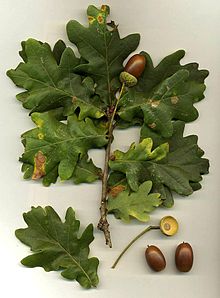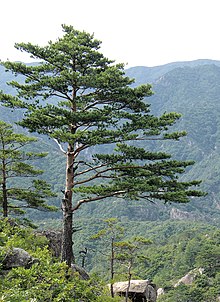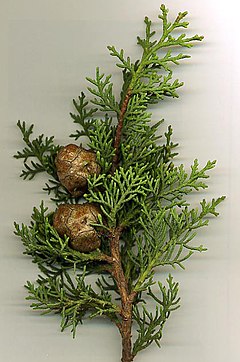#1 By: Aaron Makaruk, September 13th, 2013 03:29
What are the different materials options for building hives? Strengths and weaknesses?
#2 By: Aaron Makaruk, September 13th, 2013 03:32

Juniperus virginiana (Eastern Red-cedar,Red Cedar, Eastern Juniper, Red Juniper, Pencil Cedar) is a species of juniper native to eastern North America from southeastern Canada to the Gulf of Mexico and east of the Great Plains. Further west it is replaced by the related Juniperus scopulorum (Rocky Mountain Juniper) and to the southwest by Juniperus ashei (Ashe Juniper). The Lakota Native American name is Chansha, "redwood" or Hante'. In its native range it is commonly called "cedar" or "red cedar...
#3 By: Aaron Makaruk, September 13th, 2013 03:32

An oak is a tree or shrub in the genus Quercus (/ˈkwɜrkəs/;Latin "oak tree"), having approximately 600 extant species. The common name "Oak" may also appear in the names of species in related genera, notably Lithocarpus. The genus is native to the Northern Hemisphere, and includes deciduous and evergreen species extending from cool temperate to tropical latitudes in Asia and the Americas. The center of endemism is regarded as North America, particularly Mexico. Oaks have spirally arranged leaves,...
#4 By: Aaron Makaruk, September 13th, 2013 03:33

Pines are conifer trees in the genus Pinus /ˈpaɪnəs/, in the family Pinaceae. They are the only genus in the subfamily Pinoideae. There are about 115 species of pine, although different authorities accept between 105 and 125 species. The modern English name pine derives from Latin pinus which some have traced to the Indo-European base *pīt- ‘resin’ (source of English pituitary. In the past (pre-19th century) they were often known as fir, from Old Norse fyrre, by way of Middle English firre. The O...
#5 By: Aaron Makaruk, September 13th, 2013 03:48

The Cupressaceae or cypress family is a conifer family with worldwide distribution. The family includes 27 to 30 genera (17 monotypic), which include the junipers and redwoods, with about 130-140 species in total. They are monoecious, subdioecious or (rarely) dioecious trees and shrubs from 1–116 m (3–379 ft) tall. The bark of mature trees is commonly orange- to red- brown and of stringy texture, often flaking or peeling in vertical strips, but smooth, scaly or hard and square-cracked in some spe...
#6 By: Lars Schulz, October 6th, 2013 17:48
Hey there, to get started, I throw in some feedback on hive wood options...
Wood generally is a good option. The environmental aspect and availability, cost to mention a few. Let me note though, that styropor also has its followings, especially in colder climates. The inherently good insulation leads to less food consumption in the wintertime and sometimes extended breeding period for the bees. On the other hand, wood has advantages, when it comes to moisture and mold problems.
Overall, I agree to focus on wood for the hive, I put my considerations here, so that a more informed basis is created.
#7 By: Aaron Makaruk, October 30th, 2013 18:18
Hi Lars,
I had no idea about this option, but it looks really interesting:

#8 By: DingbatCA, November 13th, 2013 16:50
I have built many hives and find red cedar to be the most pleasant to work with, but costly.
Pine is cheap and readily available where I live.
What about the best of both worlds? I was pondering a hybrid of 3 materials. Pine for the out side, a core of Styrofoam, or other foam type product, and an cedar covering the inside layer.
Am I crazy?
#9 By: Wagner Pierre, November 18th, 2013 10:48
Hehe, I also answered this topic in the painting section:
I use Meleze wood most likely Larix decidua.
It's expensive and a little heavier, but it's long lived and require no treatment.
We do wax the inside thought so that the condensing water can slide out throught my mesh floor.
#10 By: Joe Meyer, December 2nd, 2013 19:39
In nature, honeybees will coat the inside of a tree cavity with propolis to seal the hive. There are also theories this is to help with condensing moisture from curing honey on the hive walls (good read: https://archive.org/stream/cu31924003100306#page/n1/mode/2up)
Recent research from the Univ of Minnesota implies this may provide benefits to the colony's immune system since propolis is antibacterial, antifungal... ( http://en.wikipedia.org/wiki/Propolis#Biomedical_research )
This propolis envelop is absent on managed hives today since the inside walls are typically smooth sanded pine. Future hive designs could include rough lumber on the inside.
I tried scratching up the inside walls on my hives last summer with an uncapping fork, it didn't cause much propolizing.
#11 By: Lee Sutherland, December 13th, 2013 12:27
The styro designs work very well. They hold heat very well in the winter, which really slashes the honey consumption of the hive compared to a wood unit with a simple winter wrap.
The residues from the polystyrene fabrication are significant, however, if that is important.
Powered by Discourse, best viewed with JavaScript enabled